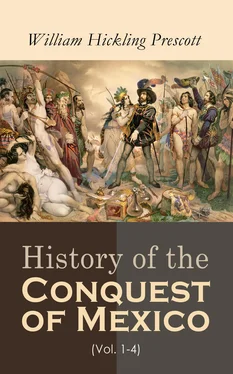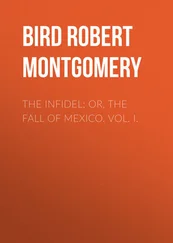The Aztec princes, especially towards the close of the dynasty, lived in a barbaric pomp, truly Oriental. Their spacious palaces [47]were provided with halls for the different councils who aided the monarch in the transaction of business. The chief of these was a sort of privy council, composed in part, probably, of the four electors chosen by the nobles after the accession, whose places, when made vacant by death, were immediately supplied as before. It was the business of this body, so far as can be gathered from the very loose accounts given of it, to advise the king, in respect to the government of the provinces, the administration of the revenues, and, indeed, on all great matters of public interest. [48]
In the royal buildings were accommodations, also, for a numerous body-guard [49]of the sovereign, made up of the chief nobility. It is not easy to determine with precision, in these barbarian governments, the limits of the several orders. It is certain there was a distinct class of nobles, with large landed possessions, who held the most important offices near the person of the prince, and engrossed the administration of the provinces and cities. [50]Many of these could trace their descent from the founders of the Aztec monarchy. According to some writers of authority, there were thirty great caciques , who had their residence, at least a part of the year, in the capital, and who could muster a hundred thousand vassals each on their estates. [51]Without relying on such wild statements, it is clear, from the testimony of the Conquerors, that the country was occupied by numerous powerful chieftains, who lived like independent princes on their domains. If it be true that the kings encouraged, or, indeed, exacted, the residence of these nobles in the capital, and required hostages in their absence, it is evident that their power must have been very formidable. [52]
Their estates appear to have been held by various tenures, and to have been subject to different restrictions. Some of them, earned by their own good swords or received as the recompense of public services, were held without any limitation, except that the possessors could not dispose of them to a plebeian. [53]Others were entailed on the eldest male issue, and, in default of such, reverted to the crown. Most of them seem to have been burdened with the obligation of military service. The principal chiefs of Tezcuco, according to its chronicler, were expressly obliged to support their prince with their armed vassals, to attend his court, and aid him in the council. Some, instead of these services, were to provide for the repairs of his buildings, and to keep the royal demesnes in order, with an annual offering, by way of homage, of fruits and flowers. It was usual, if we are to believe historians, for a new king, on his accession, to confirm the investiture of estates derived from the crown. [54]
It cannot be denied that we recognize, in all this, several features of the feudal system, [55]which, no doubt, lose nothing of their effect under the hands of the Spanish writers, who are fond of tracing analogies to European institutions. But such analogies lead sometimes to very erroneous conclusions. The obligation of military service, for instance, the most essential principle of a fief, seems to be naturally demanded by every government from its subjects. As to minor points of resemblance, they fall far short of that harmonious system of reciprocal service and protection which embraced, in nice gradation, every order of a feudal monarchy. The kingdoms of Anahuac were in their nature despotic, attended, indeed, with many mitigating circumstances unknown to the despotisms of the East; but it is chimerical to look for much in common—beyond a few accidental forms and ceremonies—with those aristocratic institutions of the Middle Ages which made the court of every petty baron the precise image in miniature of that of his sovereign.
The legislative power, both in Mexico and Tezcuco, resided wholly with the monarch. [56]This feature of despotism, however, was in some measure counteracted by the constitution of the judicial tribunals,—of more importance, among a rude people, than the legislative, since it is easier to make good laws for such a community than to enforce them, and the best laws, badly administered, are but a mockery. Over each of the principal cities, with its dependent territories, was placed a supreme judge, appointed by the crown, with original and final jurisdiction in both civil and criminal cases. There was no appeal from his sentence to any other tribunal, nor even to the king. He held his office during life; and any one who usurped his ensigns was punished with death. [57]
Below this magistrate was a court, established in each province, and consisting of three members. It held concurrent jurisdiction with the supreme judge in civil suits, but in criminal an appeal lay to his tribunal. Besides these courts, there was a body of inferior magistrates, distributed through the country, chosen by the people themselves in their several districts. Their authority was limited to smaller causes, while the more important were carried up to the higher courts. There was still another class of subordinate officers, appointed also by the people, each of whom was to watch over the conduct of a certain number of families and report any disorder or breach of the laws to the higher authorities. [58]
In Tezcuco the judicial arrangements were of a more refined character; [59]and a gradation of tribunals finally terminated in a general meeting or parliament, consisting of all the judges, great and petty, throughout the kingdom, held every eighty days in the capital, over which the king presided in person. This body determined all suits which, from their importance or difficulty, had been reserved for its consideration by the lower tribunals. It served, moreover, as a council of state, to assist the monarch in the transaction of public business. [60]
Such are the vague and imperfect notices that can be gleaned, respecting the Aztec tribunals, from the hieroglyphical paintings still preserved, and from the most accredited Spanish writers. These, being usually ecclesiastics, have taken much less interest in this subject than in matters connected with religion. They find some apology, certainly, in the early destruction of most of the Indian paintings, from which their information was, in part, to be gathered.
On the whole, however, it must be inferred that the Aztecs were sufficiently civilized to evince a solicitude for the rights both of property and of persons. The law, authorizing an appeal to the highest judicature in criminal matters only, shows an attention to personal security, rendered the more obligatory by the extreme severity of their penal code, which would naturally have made them more cautious of a wrong conviction. The existence of a number of co-ordinate tribunals, without a central one of supreme authority to control the whole, must have given rise to very discordant interpretations of the law in different districts. But this is an evil which they shared in common with most of the nations of Europe.
The provision for making the superior judges wholly independent of the crown was worthy of an enlightened people. It presented the strongest barrier that a mere constitution could afford against tyranny. It is not, indeed, to be supposed that, in a government otherwise so despotic, means could not be found for influencing the magistrate. But it was a great step to fence round his authority with the sanction of the law; and no one of the Aztec monarchs, so far as I know, is accused of an attempt to violate it.
To receive presents or a bribe, to be guilty of collusion in any way with a suitor, was punished, in a judge, with death. Who, or what tribunal, decided as to his guilt, does not appear. In Tezcuco this was done by the rest of the court. But the king presided over that body. The Tezcucan prince Nezahualpilli, who rarely tempered justice with mercy, put one judge to death for taking a bribe, and another for determining suits in his own house,—a capital offence, also, by law. [61]
Читать дальше












